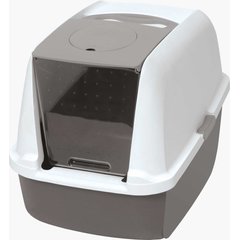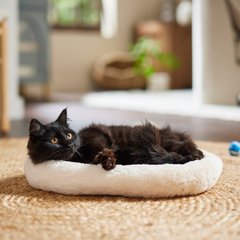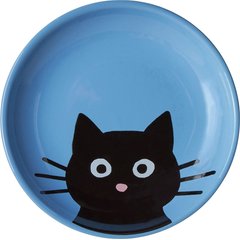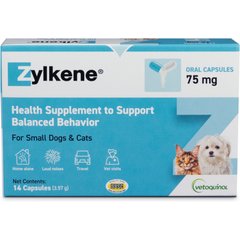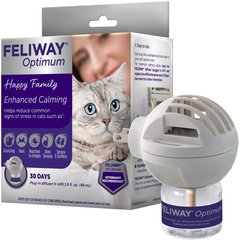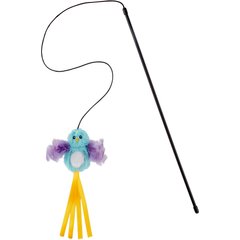Have a ‘Mean Cat’? Here’s What Cat Aggression Means and How To Handle It
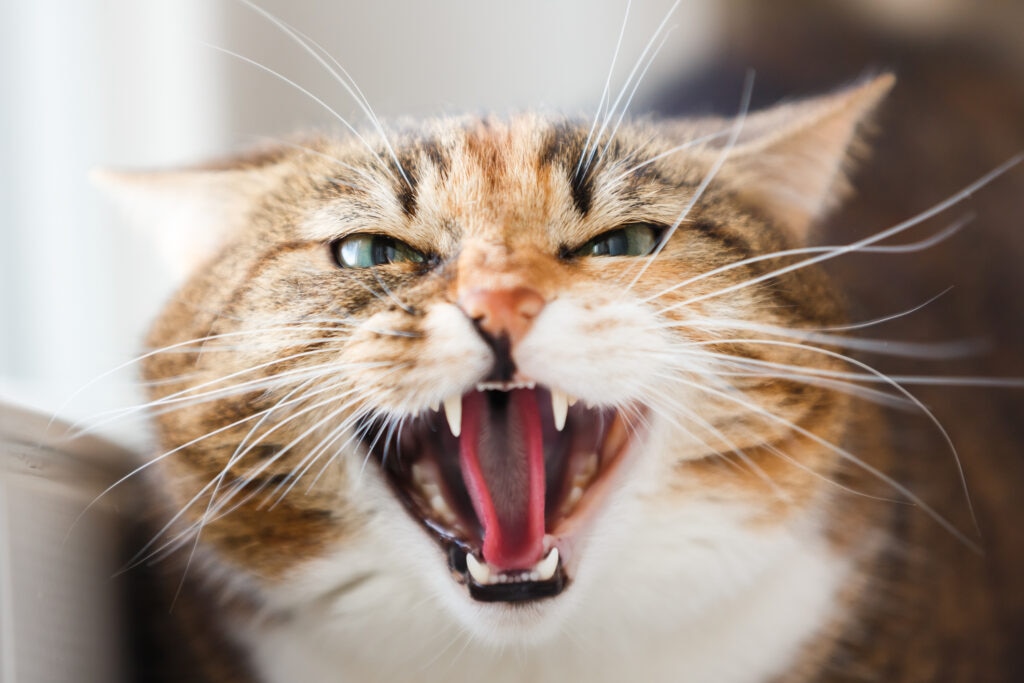
Photo by castenoid/iStock/Getty Images Plus
Do you feel like you have a “mean cat”? When your sweet housemate turns sour, attacking feet, swatting, or even biting, it’s rarely a sign of malice. Rather, cat aggression is a form of communication, often signaling an unmet need or underlying medical issue.
By recognizing subtle shifts in body language, you can give your cat the space they’re asking for before their behavior escalates. Changing a few things at home and taking your cat to the vet for any new or sudden behavior changes are the first steps toward a better relationship with your cat.
Key Takeaways
- Cat aggression is often a sign of unmet needs or underlying medical issues, not malice.
- Defensive behavior is often mistaken for aggression in cats.
- Common causes of cat aggression include resource guarding, overstimulation, and redirected stress.
- If your cat is suddenly acting aggressive, take them to the vet for an exam.
What Does an Aggressive Cat Look Like?
Hissing is far from the first sign of aggression in cats. Signs of aggression begin with subtle clues, such as:
- A stiff, quickly swishing tail
- A tense, upright body posture
- Direct, unblinking eye contact
- Ears twitching or slightly rotated
- Dilated pupils
- Rippling skin
If you don’t pick up on their subtle hints, cats may choose to escalate their body language or vocalizations to drive the point home, such as:
- Ears pinned back
- Low, rumbling growls or yowls
- Snarling, hissing, or spitting
- Puffing up their fur to look bigger
- Standing tall or even moving forward rather than retreating
- Delivering sharp swats
- Biting
Not every cat who hisses, swats, or bites is truly “aggressive,” says Marc Smith, DVM, MS, veterinarian and owner of Natchez Trace Veterinary Services in Nashville, Tennessee.
Many cats are unfairly labeled as the “mean cat” or the “aggressive cat” when they are actually acting defensively. These cats are reacting out of fear, stress, or discomfort, rather than genuinely challenging or asserting dominance.
Defensive vs. Aggressive Cat Behaviors
Misreading defensiveness as aggression can strain the cat-human bond and cause pet parents to overlook stress or pain in their cat. Learning to spot the difference helps you understand the cause of the behavior and how best to respond.
A defensive cat is trying to keep a threat away. They’ll usually:
- Hiss, give shaky yowls, or let out breathy moans
- Cower, flatten their ears, and tuck their tail
- Make themselves look smaller by crouching low
- Retreat or back away, though they may lash out if cornered
An aggressive cat, by contrast, is deliberately trying to scare off a perceived threat. They’ll usually:
- Growl or snarl in a deep, steady tone
- Hold an upright, tense stance with intense eye contact
- Puff up and make themselves look bigger
- Stand their ground or even advance toward the perceived threat
Why Do Cats Become Aggressive?
Our cats are still nearly genetically identical to the wild cats they domesticated themselves from thousands of years ago, says Samantha Bell, cat expert and content strategist for Best Friends Animal Society. With that comes more than a few primal instincts. Understanding these instincts is the first step toward a happier home.
1. Resource Aggression (Guarding)
Cats are a predator-prey species, meaning they hunt smaller animals and have natural predators in the wild.
This dual nature means that while cats are social, they also need exclusive access to essential resources to feel safe. Not having their own belongings can seriously stress cats out, which can lead to resource guarding or aggression.
2. Redirected Aggression
“Redirected aggression in cats happens when a cat either can’t reach the source of the fear or stress they’re experiencing,” says Joey Lusvardi, CCBC, owner of Class Act Cats in Minneapolis. “Instead, they’ll take it out on a nearby human or cat.”
Some everyday situations that can trigger redirected aggression include:
- Seeing another cat: Your cat spots another cat outside the window or even smells one at the front door. They may get worked up, but can’t chase the “intruder” away. Instead, that frustration might come out as swatting at you or another household pet.
- Sudden, loud noises: Fireworks, thunder, or a smoke alarm can send your cat into high-alert mode. Since they can’t “fight” the scary sound, they may lash out at whoever’s nearby.
- Returning from vet visits: In multi-cat homes, one cat coming back from the vet or groomer may smell unfamiliar. The other cat may not recognize them and treat them as a stranger or threat, leading to hissing, growling, or even one cat attacking the other.
3. Play Aggression
Play aggression occurs because a cat’s instincts to hunt aren’t being satisfied.
Cats are naturally wired to hunt several times a day, following a cycle of hunt, catch, kill, eat. If they don’t get chances to chase and pounce, they may redirect that pent-up energy toward your feet, your hand when you reach in for pets, or even an unsuspecting furry housemate.
4. Petting-Induced Aggression
Petting-induced aggression occurs when a cat becomes overstimulated or experiences sensory overload during petting, prompting them to bite or swat to stop the contact.
While it often feels out of nowhere, this type of cat aggression often happens because we miss the subtle warning signs, such as:
- Rippling or twitching skin along the back
- Rotated or flattened ears
- A flickering or low-swishing tail
- Stiffening of their body
5. Territorial Aggression
If your cat is blocking a doorway or hallway, or they are an indoor-outdoor cat getting into frequent fights in the yard, they may be experiencing territorial aggression. This behavior is triggered by the presence of a perceived intruder (a stray cat or a new pet, for example) in their established space.
Signs of territorial aggression include:
- Blocking paths (sitting in a doorway to prevent another cat from passing)
- Stalking, chasing, and ambushing the perceived intruder
- Urine spraying
6. Medical Conditions
Pain is a frequent cause for defensive behaviors in cats, such as biting when a specific, painful body part is touched. But if your senior cat is exhibiting unpredictable aggression or confusion, they may have cognitive dysfunction syndrome (CDS), or feline dementia.
Cats with CDS may become irritable, disoriented, or not recognize the familiar people or pets they love.
Treatment for Aggressive Cats
There isn’t a single treatment for cat aggression, and the fix isn’t always quick. But starting with behavioral and environmental changes is the best way to improve your relationship with your cat and move toward a more harmonious life at home.
For some cats, your veterinarian may also recommend medications to help manage their anxiety.
Resource Aggression (Guarding)
The solution for resource aggression or guarding is to provide ample resources and space.
- Litter boxes: Have one litter box per cat, plus one extra. So, if you have two cats, you’ll need three litter boxes. Place the boxes apart, in accessible and quiet locations, preferably not against walls, so your cat has more than one way in and out and can clearly see their surroundings.
Recommended Products
- Cat beds, scratching posts, and cat trees: Offer multiple of each item throughout the house so that your cats can rest and play without having to compete for the best spot.
Recommended Products
- Feeding stations: Each cat should have their own designated food bowl. These should be placed at least a few feet apart and may need to be in separate rooms if you notice aggression toward other cats during mealtime.
Recommended Products
Sticking to a feeding schedule can also help reduce resource aggression.
Feed adult cats two or more small meals throughout the day, rather than one large meal. Smaller meals help prevent guarding by removing the feeling of scarcity. Plus, Bell says it’s healthier for their digestive systems because multiple feedings better replicate a natural hunting schedule and prevent overeating.
Redirected Aggression
When you notice signs that your cat may be feeling triggered, like hissing while looking out the window or smelling and reacting aggressively to a cat who has just returned home, do not intervene with your hands or body because you’ll likely become the target of the attack.
Instead of physically interacting, try these strategies to interrupt the trigger and help your cat de-escalate safely:
- If your cat is acting aggressively after seeing another cat, gently redirect their attention with a toy or close the blinds so they can’t see the other cat. Give them time to cool down before approaching.
- If your cat is acting aggressively after another pet returns from the vet, keep the returning pet in a separate room for a few hours. You can also rub a blanket or towel on them to help re-establish a shared household smell.
- If your cat is acting aggressively after a sudden loud noise, provide safe places for your cat to retreat, like a favorite covered bed, box, or perch. These spots give them a sense of control and comfort. Create a safe, quiet space for your cat during noisy events. For known triggers, such as the Fourth of July, ask your vet if a calming aid could benefit your cat.
Recommended Products
Play Aggression
“Playing with your cat using a wand toy helps satisfy their need to bite and chase, so they won’t need to bite you or other non-consenting cats,” Bell explains.
Recommended Products
You can replicate a satisfying hunt with 10–15 minutes of play with your cat:
- The hunt: Use a wand or other favorite toy to engage your cat in a chase that simulates hunting.
- The kill: Let your cat sink their teeth and claws into the toy to satisfy their need to bite and “kill” their prey. If you’re using a laser pointer, always end the session by directing the beam onto a toy they can attack.
- The meal: Once your cat successfully “kills” their prey, give them a small treat or snack. Giving them a treat completes the hunting sequence and signals to your cat that it’s time to rest until the next hunt.
Petting-Induced Aggression
The key to avoiding overstimulating your cat is with consent-based interaction and respecting your cat’s boundaries:
- Ask for consent: Place your hand out and let your cat come to you. If they rub their head or body against your hand, they’re saying they’d like to be touched. If they don’t, respect their choice and give them space.
- Learn and respect preferences: If touching a specific spot causes your cat to stiffen their body or quickly turn their head toward your hand, try to avoid touching that area.
- Learn and respect limits: Pay close attention to your cat’s limits. For example, Bell says if your cat typically starts showing signs of annoyance after 10 full-body pets, stop at nine or switch to a less stimulating area, like the head.
- Pause: Stop petting and let your hand linger in front of your cat. If your cat presses their head against you, they are signaling they would like the interaction to continue. If they simply walk away, respect that signal.
Cognitive Decline and Other Medical Issues
Cognitive decline in cats is similar to Alzheimer’s disease in humans. While it can’t be reversed or cured, your veterinarian may prescribe medications or recommend strategies to help ease symptoms and improve your kitty’s quality of life.
Why Is My Cat Suddenly Aggressive?
It can be upsetting, confusing, and even scary when your usually sweet cat has a sudden personality shift. Whether your cat is a kitten or a senior, aggression is often a sign of an underlying medical issue that needs attention. Getting your cat examined by a veterinarian is the best way to help your buddy feel better and get back to their happy self.


